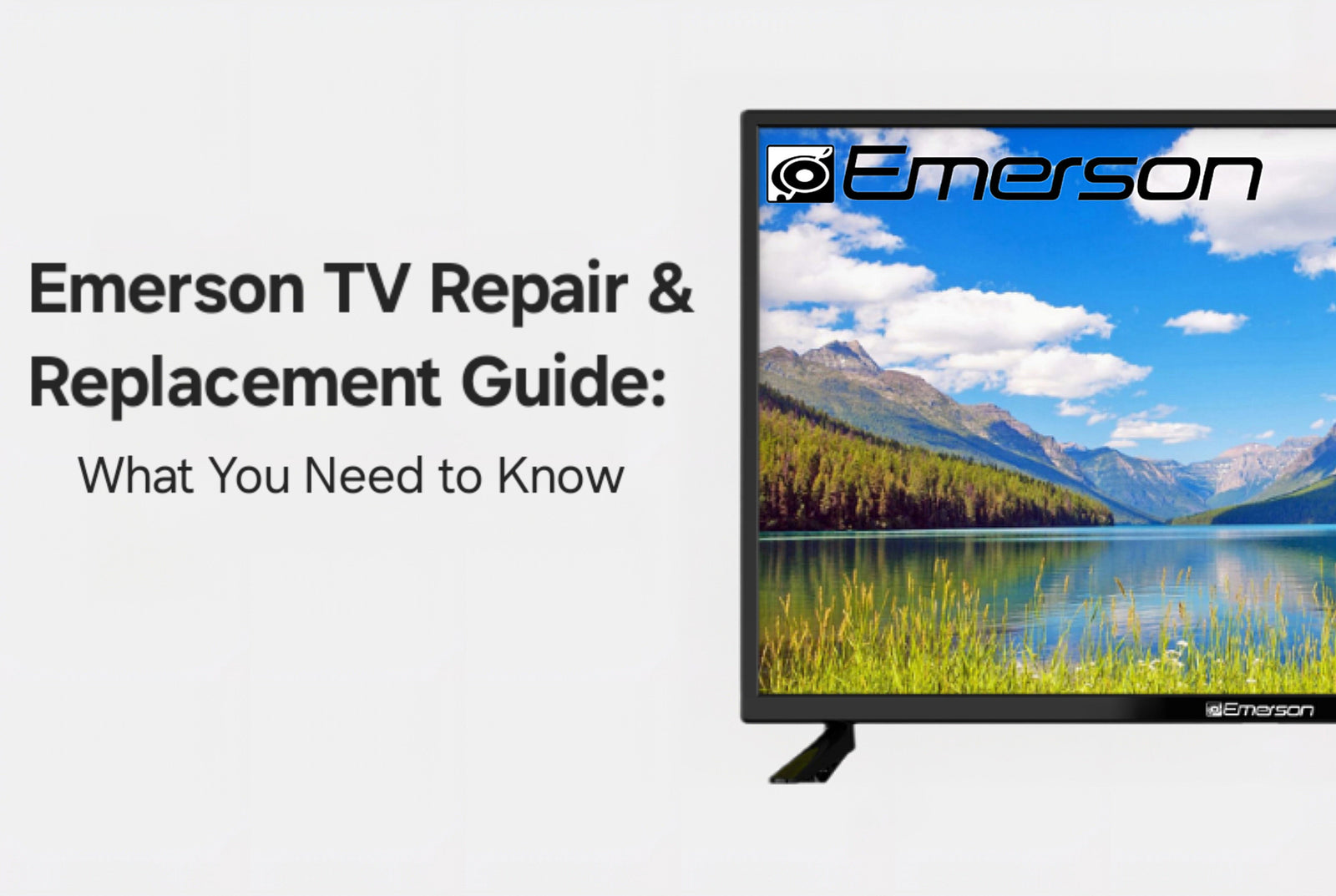Whether your Emerson TV is experiencing power issues, poor audio, or a broken screen, knowing how to properly identify and fix the problem can save you time and money. In this guide, we’ll walk you through everything from identifying your TV model to sourcing compatible parts and deciding when it's time to call in a professional. Let’s get started!
Nervous about how to proceed? Rather watch a video? Check out our helpful YouTube video on how to get started with your repair:
Identifying Your Emerson TV Model
Before diving into any troubleshooting or part replacement, it's essential to identify your exact Emerson TV model. This information is critical for finding the right components and repair guides.
Here’s where to locate the model number:
- Original Packaging/User Manual – Often listed right on the box or inside the manual.
- Back of the TV – Look for a label or sticker with the model number, serial number, and power specs.
- Settings Menu – If your TV is mounted, access the 'Settings' > 'About' section using your remote control.
TVpartsToday Tip: Write down the model number and keep it nearby - it's your key to compatible parts and instructions!
Common Components in Emerson TVs
Just like any television, Emerson TVs contain several crucial parts. Here's a rundown of the most common components you might need to replace:
- Screens – Vulnerable to cracks and dead pixels.
- Power Supply Boards – Essential for providing power to the entire unit.
- Main Boards – Handle all the input and output processing.
- Remote Controls – Frequently lost or damaged.
- Speakers – Can blow out over time or degrade in quality.
Each part varies based on your model, so always double-check compatibility using your model and part numbers. Remember, part numbers MUST MATCH EXACTLY!
Where to Find Model-Specific Information
To repair your Emerson TV correctly, you need access to model-specific information. Here are a few ways to find it:
- User Manual – Often includes part diagrams and troubleshooting steps.
- TV Label – Found on the back of the unit.
- Manufacturer’s Website – May offer downloadable manuals and parts lists.
- Emerson Customer Support – Reach out directly for part compatibility advice.
Online forums and repair sites can also offer tips from others who’ve fixed the same model. TVpartsToday is also on hand to help you out via email or phone!
(930-212-1975)
Troubleshooting Common Emerson TV Issues
Power Problems
If your Emerson TV won’t turn on:
- Check the power cord for fraying or damage.
- Try a different outlet to rule out power source issues.
- Power cycle the TV by unplugging for 60 seconds.
- Inspect the power supply board for blown capacitors (if you're comfortable opening the back).
If you're unsure, it’s best to consult a technician to avoid shock risks.
Audio/Video Quality Issues
- Check the content or input device – the issue might not be the TV.
- Secure all cable connections and replace faulty cords.
- Adjust the settings for better clarity and sound.
If problems persist, the issue may lie in the main board, speakers, or screen.
Connectivity and Smart Features
- Ensure Wi-Fi is active and working on other devices.
- Restart the TV and your router.
- Update your TV’s firmware via the settings menu.
Smart functions not working? It might be a faulty wireless adapter or outdated software.
Verifying Part Compatibility
Before purchasing:
- Match your TV model number with the part's listing.
- Locate the part number on the original component.
- Contact the supplier’s support team for help, if needed.
⚠️ Incompatible parts can cause more harm than good, so double-check everything! Shoot us an email or give us a call if you're struggling!
Replacing Emerson TV Parts: Step-by-Step
Tools & Safety First
Before you begin, make sure you have:
- Screwdrivers
- Multimeter
- Soldering iron
- Gloves and safety glasses
Always unplug the TV and let it sit for at least an hour before opening it.
Common Part Replacement Guides
- Power Supply Boards: Unscrew the back panel, disconnect cables, swap the board, reassemble.
- LED Strips: Remove the screen layers, replace strips carefully, and reassemble.
- Main Boards: Disconnect all cables, remove the board, and install the new one.
Once done, test the TV before fully closing it up.
Testing After Repair
After replacing any part:
-
Power on the TV
-
Check for the Emerson logo or image
-
Test:
-
Volume and audio clarity
-
Screen quality and resolution
-
Remote responsiveness
-
HDMI/USB inputs
-
If issues remain, double-check your work or consider getting help.
When to Call in the Pros
Is It Worth Repairing?
Ask yourself:
- How old is the TV?
- How expensive is the repair vs. buying new?
- Is the problem likely to happen again?
- Are you missing out on modern features?
Sometimes, upgrading may be the smarter (and more fun) option!
Finding a Reliable Technician
Look for:
- Certified repair techs
- Positive reviews
- Warranty on services
Make sure they’re experienced with Emerson TVs specifically.
Final Thoughts
Emerson TVs are built to last, but like any electronic, they can run into issues. With the right information, tools, and replacement parts, you can often fix the problem yourself—or know when to call in a pro.
Take your time, stay safe, and happy repairing!
Need Help?
If you’re still unsure about the issue or need to replace a part, reach out to TVpartsToday. We can help you identify the exact cause of the problem and provide the right replacement part!
Would you rather watch a video? Check out our helpful Troubleshooting 101 playlist over on YouTube!
Would you rather chat with a seasoned repair expert? Head on over to our TVRepairHelp subReddit!
Need help finding the right board or part?
Call us at 930-212-1975 or browse our inventory online.
DIY-friendly parts, fast shipping, and expert support – only at TVpartsToday.

